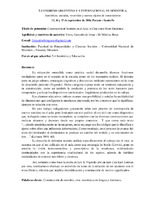Construcción de sentidos en el aula : el cine como texto didáctico
Abstract
La educación entendida como práctica social desarrolla diversas funciones mediadoras tanto en el espacio de la escuela como en los escenarios áulicos. El docente pone en juego saberes, estrategias cognitivas y discursivas mediante operaciones en la zona de desarrollo próximo (Vigotski). Dicha categoría expone tanto un territorio compartido y en construcción, como así también la condición y potencia de los seres humanos para comprender y utilizar los dispositivos intelectuales- lingüísticos producidos en la cultura.
Los planteos educativos críticos asumen esta posibilidad y señalan la multiplicidad de dimensiones que configuran la enseñanza atravesada por los contextos que la significan, siempre en relación con otros.
En este trabajo indagaremos justamente sobre este proceso de construcción de nuevos sentidos en el aula, pero limitando nuestro análisis al uso del cine como dispositivo que, trabajado como un texto incompleto, se completa con las diversas construcciones que
realizan alumnos y docentes desde sus propios contextos. Y que como todo texto “…siendo semióticamente no homogéneo, entra en juego con los códigos que lo descifran y ejerce sobre ellos una influencia deformadora. Como resultado, en el proceso de avance del texto del destinador al destinatario se produce un cambio del sentido y un crecimiento de éste…” (Lotman 1996: 60)
La elección de delimitar nuestro análisis específicamente al trabajo con el cine, se sustenta en que al ser utilizado en el aula como una estrategia de borde (Litwin), pone en tensión la visión instrumentalista y prescriptiva de la enseñanza, evidenciando continuidades con la experiencia vital/cultural de los sujetos, además de habilitar modalidades de conocer más libres y creativas.
Así, tomando como base la teoría de Lev S. Vigotski por un lado y de Luri Lotman por otro, intentaremos efectuar un recorrido en torno de la relación de los alumnos con el texto fílmico, relación que implica decodificación y construcción de nuevos significados. Education understood as social practice develops various mediating functions both in the school space and in the aulic settings. The teacher puts into play knowledge, cognitive and discursive strategies through operations in the zone of proximal development (Vygotsky). This category exposes both a territory shared and under construction, as well as the condition and power of human beings to understand and use the intellectual-linguistic devices produced in culture. Critical educational approaches assume this possibility and point out the multiplicity of dimensions that shape the teaching traversed by the contexts that mean it, always in relation to others.
In this paper we will inquire about this process of construction of new senses in the classroom, but limiting our analysis to the use of cinema as a device that, worked as an incomplete text, is completed with the various constructions that students and teachers perform from their own contexts . And that like all text “... being semiotically non-homogeneous, it comes into play with the codes that decipher it and exerts on them a deforming influence. As a result, in the process of advancement of the text of the sender to the recipient there is a change of meaning and a growth of it ...” (Lotman 1996: 60).
The choice to delimit our analysis specifically to the work with the cinema, is sustained that when being used in the classroom like a strategy of edge (Litwin), puts in tension the instrumentalist vision and prescriptive of the teaching, evidencing continuities with the vital experience / Cultural of the subjects, besides enabling modalities of knowing more free and creative.
Thus, based on the theory of Lev S. Vygotsky on the one hand and Luri Lotman on the other, we will try to make a journey around the relationship of students with the filmic text, a relationship that involves decoding and construction of new meanings
Collections
The following license files are associated with this item:




